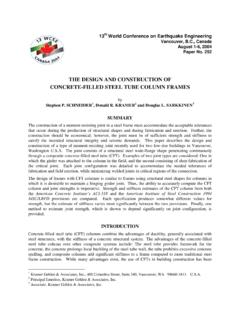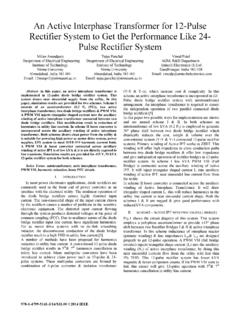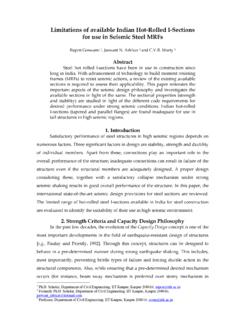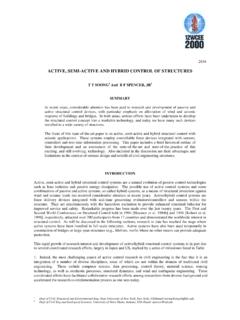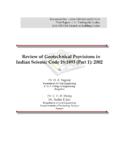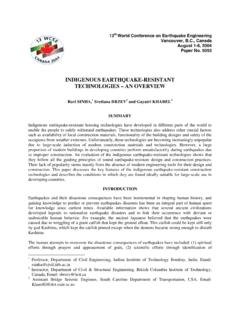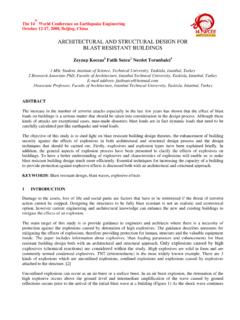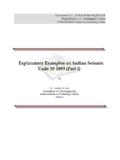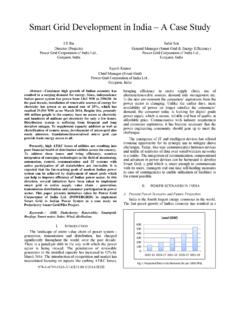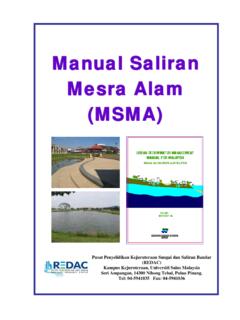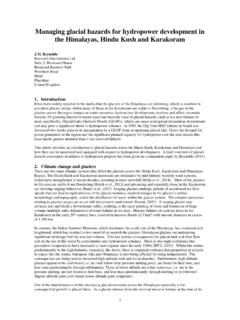Transcription of B.Tech. (Electrical Engineering) - IIT Kanpur
1 (Computer Science and engineering ). S E M E S T E R. FIRST SECOND THIRD FOURTH FIFTH SIXTH SEVENTH EIGHTH. C CHM101 TA101 MTH203 HSS-I-2 CS330 CS335 CS498 CS499. O PHY101 PHY103 CHM201 TA201 CS340 CS345. U PHY102 MTH102 CS220 CS201 ONE OUT ONE OUT. R MTH101 ESC102 ESO-1 CS355 OF OF. S HSS-I-1/ CS100 ESO211 OE-1 CS350, CS315, E ENG112N PE102 CS425, CS365, ESC101 CS455 CS422. PE101. In addition to above, the student must complete the following credits: DE 12 Credits OE 20 Credits HSS-2 08 Credits SE 08 Credits ( electrical engineering ). S E M E S T E R. FIRST SECOND THIRD FOURTH FIFTH SIXTH SEVENTH EIGHTH. C PHY102 PHY101 MTH203 HSS-I-2 EE320 EE340 EE491 EE492. O MTH101 CHM101 CHM201 ESO209 EE330 EE381. U TA101 MTH102 TA201 ESO210 EE370 3 OUT OF: R ESC102 ESC101 EE200 EE210 EE380 EE301.
2 S PE101 EE100 ESO202/ EE250 EE311. E HSS-I-1/ PHY103 ESO211/ EE321. ENG112N PE102 ESO214/ EE360. ESO218. In addition to above, the student must complete the following credits: DE 12 Credits OE 16 Credits HSS-2 08 Credits SE 08 Credits 32. CORE COURSES. CHM 101 CHEMISTRY LABORATORY. L-T-P-D-[C]. 0-1-3-0-[2] Permanganometric Titrations, Acid - Base titrations, Iodometric titrations, Complexometric titrations, Dichrometric titrations, Recycling of aluminium, Preparation and analysis of a metal complex, Polynuclear metal complexes with multidentate briding ligands, Chromatography of natural pigments, Viscosity of solutions, Chemical kinetics, Heterogeneous equilibrium, Photochemical oxidation - reduction, Application of free electron model, Spectrophotometric estimation, Synthesis of antioxidants used as food preservatives, Preparation of polymer films, Preparation of azo-dyes and dyeing, Resolution of commercial Ibuprofen.
3 CHM 201 CHEMISTRY. L-T-P-D-[C]. 3-1-0-1-[4] Physical Principles: Experimental methods of structure determination, Systems at finite temperature, Molecular reaction dynamics. Chemistry of Molecules: Introduction to molecules, Principles and applications of Transition Metal ion chemistry, Organometallic chemistry, Green chemistry, Structure of organic molecules, Synthesis of organic molecules, Photochemistry of organic and biomolecules, Chemistry of life processes, Biotechnology and Biomedical applications. ESC 101 FUNDAMENTALS OF COMPUTING. L-T-P-D-[C]. 3-1-3-0-[5] introduction to Linux, the programming environment, write and execute the first program, introduction to the object oriented (OO) approach-classes, objects, state through member variables, interface through member functions/.
4 Methods. Give many examples of (OO) approaches to problem solving in science and engineering , Procedural programming, Introduction to basic input-output - Assignment and expressions, Control: if, if-then-else, case, go, continue, break, Loops, interators, enumerations examples form algebraic equation solving, Function as a procedural abstraction, argument passing, references, Basic containers: Array, Vector, examples from solving systems of linear equations, Recursion, Object-oriented aspects, Programming using classes and objects, Scope, encapsulation, visibility, Inheritance, subtypes, static-dynamic binding, Primitive types, classes as types, wrapper classes for primitive types Java i/o system, More container classes-list, hashtable, set, sortedset, algorithms which use these classes, Interfaces.
5 20. ESC 102 INTRODUCTION TO ELECTRONICS. L-T-P-D-[C]. 3-1-3-1-[5] Passive components, Signal sources, DC circuit analysis, Time domain response of RC and RL circuits, Discrete electronic devices, Sinusoidal steady state response, phasor, impedance, Two port network, basic feedback theory, frequency response, transfer function, DC Power supply, BJT biasing, Simple transistor amplifier, differential amplifier, Op-amp, Circuits using op-amp, Waveform generators, 555 timer, Simple active filters, Logic gates, multiplexers, combinatorial circuits, Combinatorial circuit design, K-map, Sequential circuits, Flip-flops, Counters, shift registers, sequence generators, DA converters, AD. converters, Basic micro-computer architecture. Laboratory Experiments : Familiarization with passive components, function generator and oscilloscope, Step and frequency response of RC and RL.
6 Circuits, Some electronic components and their characteristics, DC power supply, Voltage amplifiers using op-amp, Comparators, Schmitt trigger and Active filters, Waveform generators using op-amp and 555 timer, Combinatorial circuits, Sequential circuits, Digital-to-analog converters and analog-to- digital converters. ESO 202 THERMODYNAMICS. L-T-P-D-[C]. 3-1-0-1-[4] Definitions & concepts: SI Units; System; Property; Energy; Thermodynamic Equilibrium; Work, State Postulate; Zeroth Law of Thermodynamics; Temperature Scale, Thermodynamic Properties of Fluids: Mathematical, Tabular and Graphical representation of data; Ideal gas Van der Waals Equation of state; Compressibility chart; Thermodynamic Diagrams including Mollier diagram; Steam Tables, First law of Thermodynamics & its applications to Non flow processes, Applications of First Law of Thermodynamics of Flow Processes; Steady state Steady flow and Transient flow processes, Applications of First Law of Thermodynamics to Chemically Reacting Systems Second Law of Thermodynamics & its Applications, Thermodynamic Potentials, Maxwells Relations.
7 Thermodynamic Relations and Availability, Power Cycles, Refrigeration Cycles; SI Units, Definitions & Concepts: System, Property, Energy, Thermodynamic Equilibrium, Work interaction &. various modes of work, Heat, State Postulate, Zeroeth Law of Thermodynamics, Temperature Scale, IPTS. Thermodynamic Properties of Fluids: Pure substance. Phase, Simple compressible substance, Ideal gas Equation of state, van der Waals Equation of State; Law of corresponding states, Compressibility chart, Pressure-volume; Temperature- volume and Phase diagrams; Mollier diagram and Steam tables. 21. First Law of Thermodynamics & its consequences, Applications of First Law for elementary processes, First Law analysis of Non-flow processes; Use of steam tables & Mollier diagram, Application of First Law of Thermodynamics for Flow Process-Steady state, steady flow processes, Throttling process; Transient Flow Processes-Charging & discharging of tanks.
8 First Law Applications to Chemically Reacting Systems: Fuels & Combustion, Theoretical Air/Fuel ratio, Standard heat of Reaction and effect of temperature on standard heat of reaction, Adiabatic flame temperature. Second Law of Thermodynamics & its Applications: Limitations of the First Law of Thermodynamics, Heat Engine, Heat Pump/Refrigerator. Second Law of Thermodynamics - Kelvin Planck and Clausius statements & their equivalence, Reversible & irreversible processes, Criterion of reversibility, Carnot cycle &. Carnot principles, Thermodynamic Temperature scale, Clausius inequality, Entropy, Calculations of entropy change, Principle of entropy increase, T- S diagram, II Law analysis of Control volume. Thermodynamic Potentials; Maxwell relations; Available energy, Availability.
9 Second law efficiency. Thermodynamic relations, Jacobian methods, Clapeyron and Kirchoff equations, Phase rule. Power Cycles: Rankine cycle- Ideal, Reheat and Regenerative Rankine cycles. Gas Power Cycles: Otto cycle, Diesel cycle, Dual cycle and Brayton cycle, Refrigeration Cycles: Vapor compression refrigeration, Absorption refrigeration and Gas refrigeration Cycles. ESO 204 MECHANICS OF SOLIDS, 3-1-0-1-4. L-T-P-D-[C]. 3-1-0-1-[4] Free body diagram, Modelling of supports, Conditions for Equilibrium, Friction Force-deformation relationship and geometric compatibility (for small deformations). with illustrations through simple problems on axially loaded members and thin- walled pressure vessels, Force analysis (axial force, shear force, bending moment, and twisting moment diagrams) of slender members (singularity functions not to be used), Concept of stress at a point, Transformation of stresses at a point, Principal stresses, Mohr's circle (only for plane stress case), Displacement field, Concept of strain at a point, Transformation of strain at a point, Principal strains, Mohr's circle (only for plane strain case)
10 , Strain Rosette, Modelling of problem as a plane stress or plane strain problem, Discussion of experimental results on 1-D material behaviour, Concepts of elasticity, plasticity, strain-hardening, failure (fracture/yielding), idealization of 1-D stress-strain curve, Concepts of isotropy, orthotropy, anisotropy, Generalized Hooke's law 22. (without and with thermal strains), Complete equations of elasticity, Torsion of circular shafts and thin-walled tubes (plastic analysis and rectangular shafts not to be discussed), Bending of beams with symmetric cross-section (normal and shear stresses) (shear centre and plastic analysis not to be discussed), Combined stresses, Yield criteria, Deflection due to bending, Integration of the moment-curvature relationship for simple boundary conditions, Superposition principle (singularity functions not to be used), Concepts of strain energy and complementary strain energy for simple structural elements (those under axial load, shear force, bending moment, and torsion)

